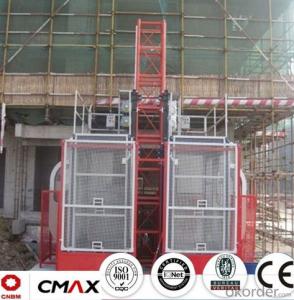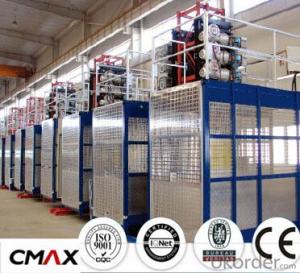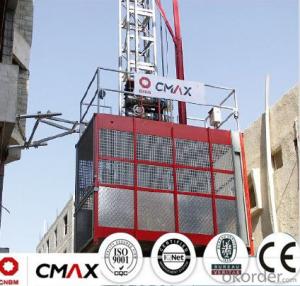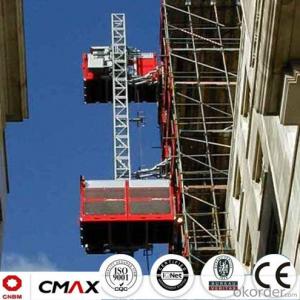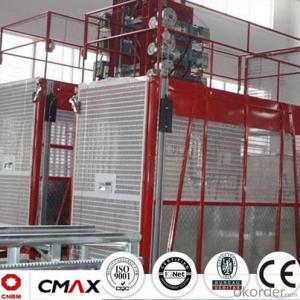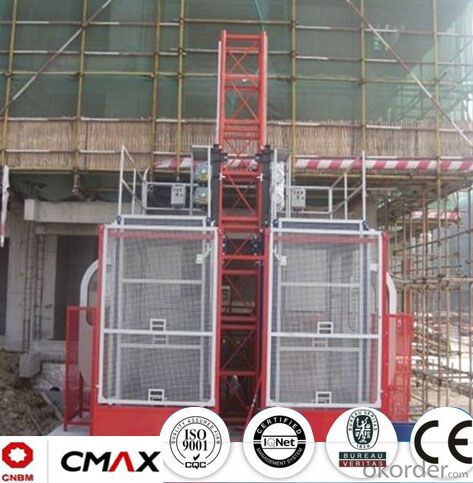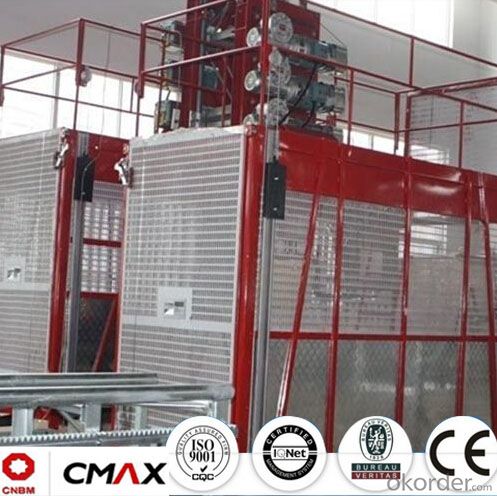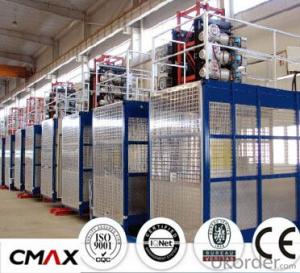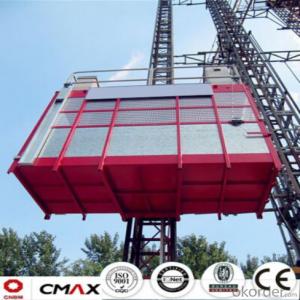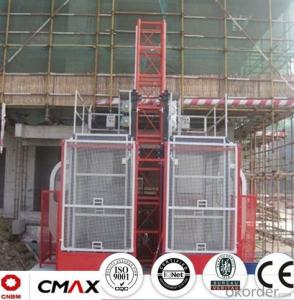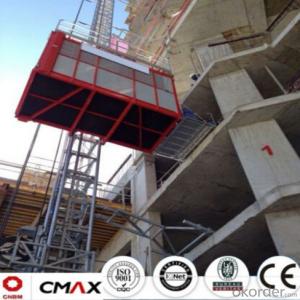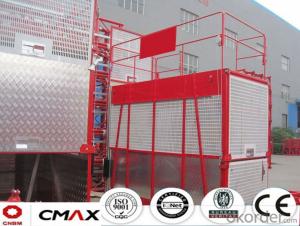Building Hoist Hot Galvanizing Mast Section with 5ton
- Loading Port:
- China main port
- Payment Terms:
- TT OR LC
- Min Order Qty:
- 1 unit
- Supply Capability:
- 5 unit/month
OKorder Service Pledge
OKorder Financial Service
You Might Also Like
Structure of Building Hoist Description
1.The gearing select perfect bearing,strong cables and oil seal.
2.The electrical parts select products from famous world manufacturers for example Schneider,Siemens and LG.
3.The racks and pinion select advanced material and advanced technique,which enhance the life of all parts.
4.The steel structure adopted strong steel from famous native manufacturers.
5.The surface of the steel structure can adopt paint-spray,parkerizing baking finish or hot galvanizing processing depending on users requirement.
6.The cage can be made and decorated by aluminum molded board,punched-plate or figured aluminum board.
Packaging & Delivery of Building Hoist
Packaging: nude and wooded box Delivery: 25-30days
Mains Parts of Building Hoist
1.The steel structure for example the mast, tie in and cabin ,could be all spay-painted and hot galvanized. Mast section is made with high quality Q345B which is the top standared in China.
2.Electrical parts are all adopted with Schneider , Siemens and other famous brands.
3.The electrical system can be selected with the normal control method and VVVF+PLC control way. Inverter we selected is from Schneider. Yaskawa or other world renowned brand.
4.Cabin exit door select ramping type. The ramping door looks like a bridge between the construction hoist and construction building.
5.The cabin floor is made from 3MM thickness steel riffled board(Hot dip galvanized), and 15MM thickness wooden board which can reduce the vibration and deformation a lot.
6.Driving unit is adopted the products from ZHANGJIANG and other reputed maker, or from SEW, NORD.
7.Safety system is mainly composed of electrical motor braking, anti-drop safety device, top & bottom limit switches, top & bottom 3-phase switches, door limit switches, buffer device and over-load protection. The system aims to ensure the hoist are running safely.
8.Qualification: CE, ISO9001:2008 and etc.
9.The long-term operation of CMAX building hoists testifies CMAX hoist is working performance is stable.
Building Hoist Images



Building Hoist Specification

FAQ of Building Hosit
Q: What is the building hoist main purpose?
A: Building hoist equipped with double or single cabin to transport the materials and labors up and down. It's the ideal construction equipment for vertical transportation in the field of construction.
Q: What is the main structure of building hoist?
A: The P/M construction hoist mainly contains metal structure, driving system, electrical control system, cable guide & protection system, electrical top crane and safety device.
Q: What is the meaning of the building hoist’s code?
A: Take SC200/200 for example: “SC” stands for rack and pinion hoist, “200/200” stands for double cage and capacity is 2 tons per cage. “SC200” stands for single cage and capacity is 2 tons.
Q: What is the dimension of the cage?
A: Normally the cage dimension is 3X1.5X2.5M (L/W/H) for 2t type hoist. Details should be checked according to our
quotation sheet. Also, the size can be customized according to the factual site condition. There are two doors (entrance& exit doors) for each cage, It can be produced as up & down sliding or ramping model for safety and convenience.
- Q: What are the safety measures to be taken to avoid accidents involving lifting equipment on construction sites?
- <p>To prevent accidents related to lifting equipment in construction work, several key safety measures should be implemented. These include regular inspections and maintenance of lifting equipment to ensure it is in good working order. Operators must be trained and certified for the specific equipment they are using. Safe lifting practices should be followed, such as using proper lifting techniques, not overloading equipment, and ensuring the load is balanced. A thorough risk assessment should be conducted before each lift, and a competent person should supervise the operation. Additionally, clear communication protocols should be established, and all workers should be trained in recognizing and avoiding hazards associated with lifting equipment.</p>
- Q: Safe use of construction elevator
- 1, seek professional installation. 2, pay attention to safety when using, don't worry, because the elevator is not as fast as the elevator. 3, if there is a broken part, change it quickly, don't delay and feel free
- Q: Explain the distinctions between electric and manual building hoists, focusing on their operation, efficiency, and use cases.
- <p>Electric building hoists are powered by electricity and offer faster operation, greater efficiency, and the ability to lift heavier loads. They are ideal for large-scale construction projects where rapid movement of materials is necessary. In contrast, manual hoists are operated by hand and are typically smaller, more portable, and require human effort to lift materials. They are suitable for smaller projects or where power supply is limited. Electric hoists are more automated and can be controlled remotely, while manual hoists require constant physical effort and are less efficient in terms of speed and load capacity.</p>
- Q: Why is the construction elevator open on one side and the other on the other
- The two-door design is designed for the safety of the operator. In the discharge mouth, if you set up a single door, a large portion of your body will be exposed outside, causing falling damage.
- Q: What measures should be taken to ensure safety when operating electric-motor powered building hoists?
- <p>When using electric-motor type building hoists, safety precautions include: ensuring all safety devices are in good working order, regularly inspecting and maintaining the hoist, following the manufacturer's guidelines, never overloading the hoist, keeping the hoist and its surroundings clean and free from obstructions, using proper lifting techniques, ensuring the hoist is stable and secure, wearing appropriate personal protective equipment, and training operators on the safe use of the hoist. Adhering to these precautions can significantly reduce the risk of accidents and ensure the safety of workers and the integrity of the construction process.</p>
- Q: Explain how a lifting platform, specifically a building hoist, operates.
- <p>A building hoist, also known as a construction hoist, is a temporary lifting platform used in construction to lift materials and personnel vertically within a building under construction. It operates by using a motor-driven pulley system that runs on guide rails or tracks. The hoist is attached to the building structure and as the building grows, the hoist is extended upwards. The platform is loaded with materials or workers, and the operator controls the ascent or descent through an electrical switch or remote control. Safety features include limit switches to prevent over-travel, safety catches to stop the platform in case of a cable failure, and interlocks to ensure the platform cannot be operated when the doors are open.</p>
- Q: This question asks for a comparison between two types of building hoists: those that are electric and those that use electric motors. It seeks to understand the key distinctions between these two systems.
- <p>Electric building hoists are powered directly by electricity and typically use simpler electric motors for lifting and lowering loads. They are generally easier to install and operate, with direct control over the motor speed and direction. On the other hand, electric-motor building hoists are more complex, often incorporating advanced motor technologies and control systems. These hoists may offer features like variable speed control, energy efficiency, and smoother operation. The main differences lie in the sophistication of the motor and control systems, with electric-motor hoists often providing more precise control and better performance for heavy-duty applications.</p>
- Q: What are the necessary safety rules and regulations that must be followed when operating a building hoist?
- <p>Safety regulations for using a building hoist include ensuring that the hoist is regularly inspected and maintained by qualified personnel. Operators must be trained and certified. The hoist should be equipped with safety devices such as limit switches, overload protection, and emergency stop buttons. Loads should never exceed the hoist's capacity, and the hoist should not be used in adverse weather conditions. Proper communication procedures must be followed, and a safety zone should be established around the hoist to prevent unauthorized access. Workers must wear appropriate personal protective equipment, and all safety guards and barriers must be in place and functioning correctly. Compliance with local and national regulations is also mandatory.</p>
- Q: This question asks for a description of the process of using a hydraulic cylinder in the context of a building hoist.
- <p>To use a hydraulic cylinder in a building hoist, first ensure the hoist is properly installed and secured. Connect the hydraulic cylinder to the hoist's power source, typically a hydraulic pump. The pump pressurizes hydraulic fluid, which is then directed into the cylinder. As the fluid enters, it pushes a piston within the cylinder, causing it to extend and lift the load. To lower the load, the fluid is released from the cylinder, allowing the piston to retract. Always monitor the pressure and ensure the system is leak-free for safe operation. Regular maintenance, including checking seals and lubricating parts, is crucial to prolong the life of the hydraulic cylinder and ensure efficient hoist performance.</p>
- Q: What is the meaning of double straps in the construction elevator?
- One component of the elevator's drag system is the weight of the car. The other side of the car is connected to the top of the car by dragging a wire rope. It can be used for the energy saving of the elevator towing system, because the elevator load optimization is calculated by the theory calculation. The elevator should be calculated before the weight is weighed: the calculation principle is that the weight is equal to the weight of the car and half the load.
Send your message to us
Building Hoist Hot Galvanizing Mast Section with 5ton
- Loading Port:
- China main port
- Payment Terms:
- TT OR LC
- Min Order Qty:
- 1 unit
- Supply Capability:
- 5 unit/month
OKorder Service Pledge
OKorder Financial Service
Similar products
Hot products
Hot Searches
Related keywords
